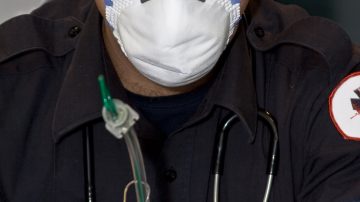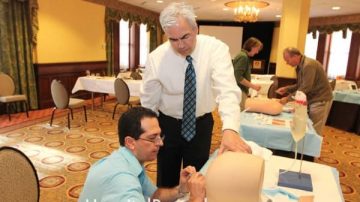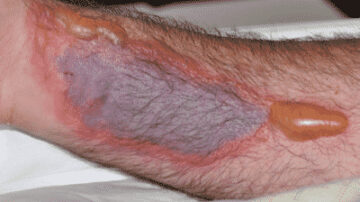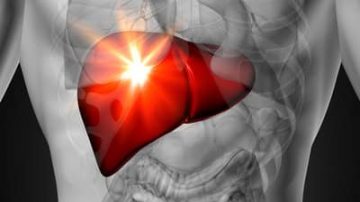The SARS-COV-2 pandemic started in January 2020 and has decimated the majority of U.S. hospitals for the past 18 months. The impact of COVID-19 has not only affected available hospital beds, but has limited the ability of hospitals to perform…
Read MoreMore Articles – Featured, Hospital Procedures, Medical General, medical procedures, Respiratory diseases
Informed consent can be challenging during “normal” times, but it has become increasingly complicated during the COVID-19 pandemic. The informed consent process ensures that a patient or their surrogate decision-maker understands the benefits, potential risks and any alternatives of a…
Read MoreMore Articles – Cardiovascular diseases, Central line, Chest Tube, Endotracheal Intubation, Featured, Hematology, medical procedures, Thoracentesis
Traditionally, it was felt that the INR had to be less than 1.5 and platelets had to be at least 50,000/µL to perform most bedside procedures. With more clinical evidence, we now know that low-risk bedside procedures can be performed…
Read MoreThe American College of Physicians (ACEP) has previously published guidelines in October 2013 about Procedural Sedation and Analgesia. In these guidelines, they provided Level B recommendations that state, “Do not delay procedural sedation in adults or pediatrics in the ED…
Read MoreMore Articles – Cardiovascular diseases, Central line, Chest Tube, Featured, Infections, King Tube, medical procedures, Respiratory diseases, Thoracentesis
More Tags – chest tube, empyema, featured, HPC updates, parapneumonic effusion, pleural effusion, thoracentesis, tube thoracostomy
Complicated parapneumonic effusions frequently represent pleural space infections. Approximately 1 in 7 cases of pneumonia have an associated parapneumonic effusion (PPE) on chest x-ray. Most of these effusions are small and usually resolve spontaneously with prompt antibiotic administration. However, moderate-to-large…
Read MoreThe Society of Airway Management recently issued guidelines for Difficult Airway Management in COVID-19 patients. The SARS CoV-2 (COVID-19) virus is extremely contagious via respiratory droplets and therefore extra precautions are needed for airway management in severe COVID-19 infection. Airway…
Read MoreMore Tags – coagulopathy, epidural hematoma, featured, HPC updates, lumbar puncture, thrombocytopenia
A recent cohort study using the Danish nationwide medical registry demonstrates that the incidence of a spinal or epidural hematoma from lumbar punctures in patients with pre-existing thrombocytopenia (Platelets<150 K) or coagulopathy (INR>1.4 or aPTT>39 seconds) is not significantly higher…
Read MoreIntraosseous line use has increased significantly since the advent of the battery powered intraosseous drill. In surveying providers at courses over the years, we have seen a steady rise in the number of providers with access to the intraosseous drill. …
Read MoreMore Tags – coagulopathy, epidural hematoma, featured, HPC updates, lumbar puncture, thrombocytopenia
Class 1 evidence to inform decisions about the safety of lumbar punctures in patients with a coagulopathy are lacking. The only guidance we have regarding the safety of lumbar punctures is based on clinical guidance from organizations such as the…
Read MorePeripheral vasopressor infusions are generally safe at low-moderate doses and for short durations, but you must watch the patient carefully for extravasation that can cause serious tissue injury. Traditionally, central lines were placed for administration of vasopressor infusions at any rate. We…
Read MoreMore Articles – Central line, Chest Tube, Emergency Procedures, Featured, Glidescope Intubation, Lumbar Puncture, Paracentesis, Thoracentesis
Medical procedural education in the era of COVID19 is still best conducted via HANDS-ON simulation-based procedural training. Procedural skills can NOT be attained via remote education, but in-person training must be conducted safely. There are many topics and skills that can be successfully be taught online,…
Read MoreThis blog will offer some expert recommendations to help guide the safety of hospital procedures at different platelet and coagulation profiles. Unfortunately, there are no strong evidence-based guidelines for hospital procedures dedicated to the study of patients with decompensated cirrhosis.…
Read MoreA historical myth in procedural medicine is the operator should limit removal of pleural fluid to 1.5 L during thoracentesis because of the risk of re-expansion pulmonary edema or pneumothorax. New evidence supports safety of large volume thoracentesis until no…
Read MoreBased on several studies, central line malposition occurs between 3.3-6.7% of the time.1 The historical recommendation is that malpositioned central lines should not be used for long periods of time, if at all. The basis for these recommendations is based…
Read MoreMore Tags – central lines, central venous catheters, featured, femoral lines, HPC updates, IJ lines, subclavian lines
The internal jugular or subclavian veins have fewer combined mechanical or infectious complications for central venous catheter insertions compared with femoral vein CVC placements. Numerous organizations have proposed guidelines or central line bundles that have advocated preferential use of the…
Read MoreCategories
- ACLS (1)
- Arterial line (33)
- Cardiovascular diseases (77)
- Central line (55)
- Chest Tube (39)
- Dermatology (4)
- Emergency Procedures (139)
- Endocrinology (6)
- Endotracheal Intubation (36)
- Events (24)
- FAST Exam (12)
- Featured (113)
- Featured Procedure (42)
- Gastrointestinal diseases (32)
- Ginecology (3)
- Glidescope Intubation (21)
- Hematology (33)
- Hospital Procedures (85)
- Infections (32)
- Intraosseous line (8)
- King Tube (27)
- Laryngeal Mask Airway (18)
- Lumbar Puncture (36)
- Mechanical Ventilation (34)
- Medical General (95)
- medical procedures (258)
- Needle Decompression (6)
- Nephrology (11)
- Neurological diseases (12)
- Oncology (4)
- Paracentesis (32)
- Pericardiocentesis (3)
- Procedural Sedation (19)
- Respiratory diseases (85)
- RUSH Exam (8)
- Thoracentesis (37)
- Traumatology (24)
- Travel (27)
- Ultrasound-Guided Peripheral IV (13)














